The Economic Impact and Evolution of Aged Care in Australia
VerifiedAdded on 2020/05/04
|16
|4807
|29
Report
AI Summary
This report provides a comprehensive overview of aged care in Australia, examining its structure, the economic impact of providing services, and its evolution over time. The report discusses the two main types of aged care: residential and community-based care, detailing the funding mechanisms and services offered under each. It explores the impact of an aging population on healthcare expenditure, analyzing the rising costs associated with aged care services. The report highlights the role of government bodies in regulating and maintaining compliance within the aged care sector. It also addresses the challenges and issues faced by the elderly, such as physical, cognitive, and social issues, and how the aged care system supports them. Finally, the report projects future trends, including increased demand for aged care services and rising costs, emphasizing the need for effective planning and resource allocation to meet the growing needs of the aging population in Australia.
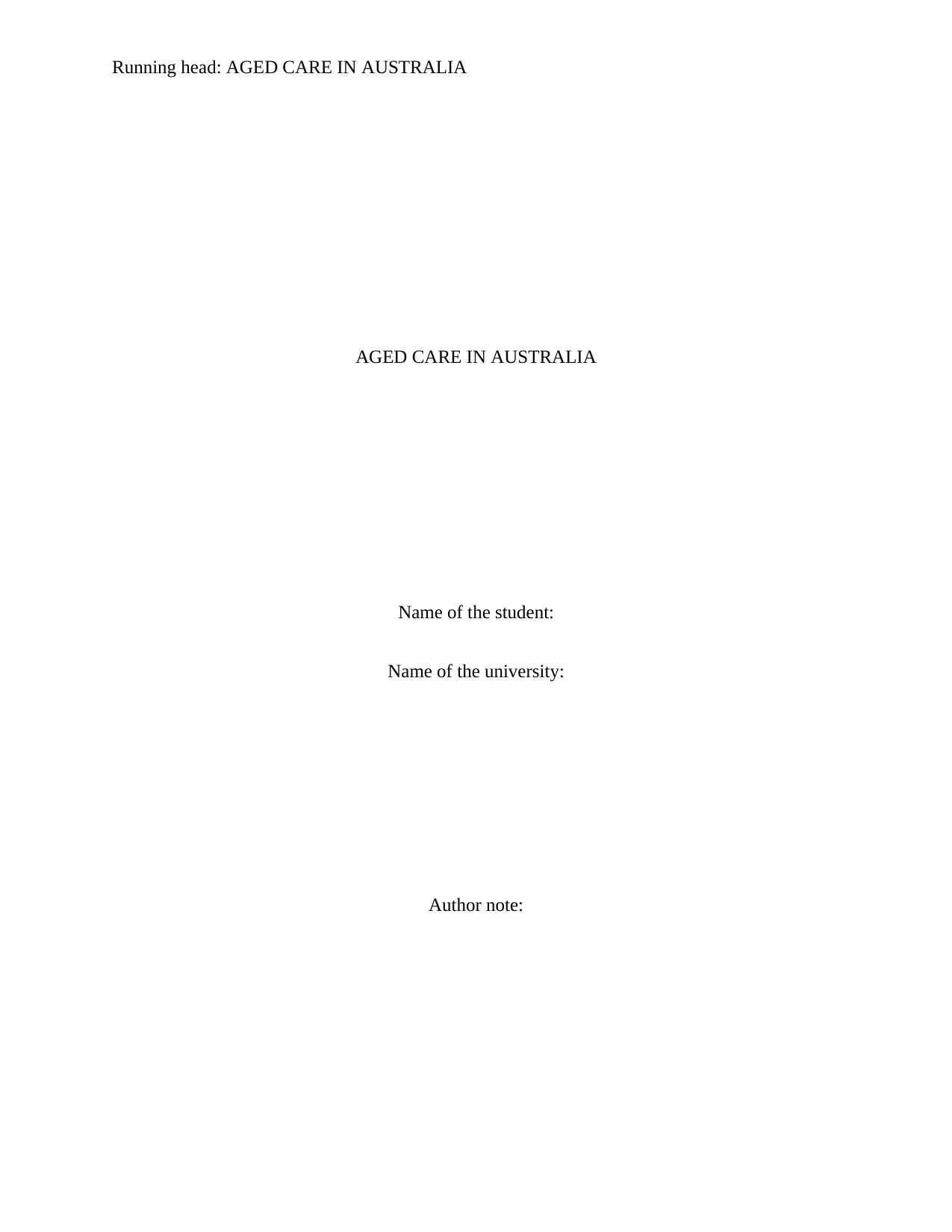
Running head: AGED CARE IN AUSTRALIA
AGED CARE IN AUSTRALIA
Name of the student:
Name of the university:
Author note:
AGED CARE IN AUSTRALIA
Name of the student:
Name of the university:
Author note:
Paraphrase This Document
Need a fresh take? Get an instant paraphrase of this document with our AI Paraphraser
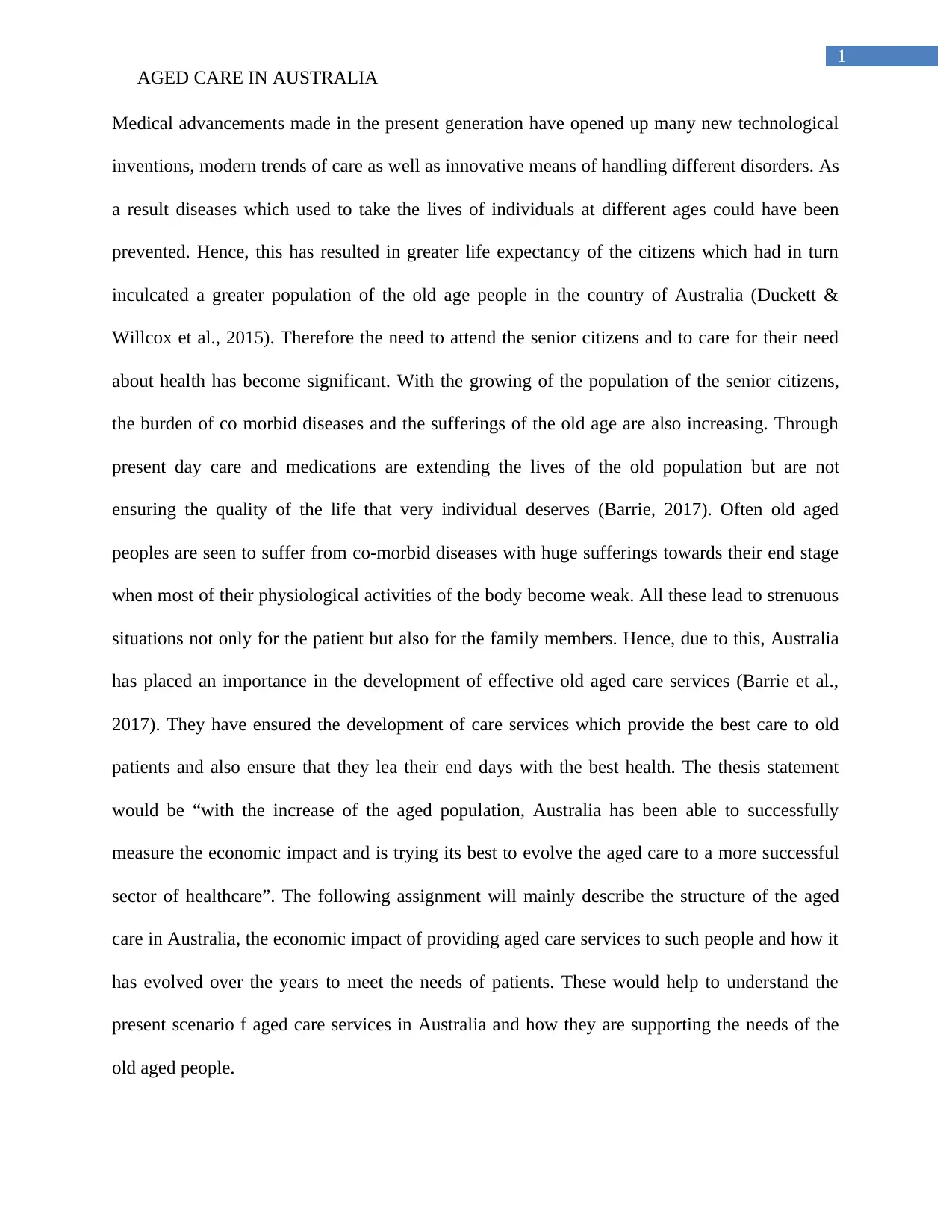
1
AGED CARE IN AUSTRALIA
Medical advancements made in the present generation have opened up many new technological
inventions, modern trends of care as well as innovative means of handling different disorders. As
a result diseases which used to take the lives of individuals at different ages could have been
prevented. Hence, this has resulted in greater life expectancy of the citizens which had in turn
inculcated a greater population of the old age people in the country of Australia (Duckett &
Willcox et al., 2015). Therefore the need to attend the senior citizens and to care for their need
about health has become significant. With the growing of the population of the senior citizens,
the burden of co morbid diseases and the sufferings of the old age are also increasing. Through
present day care and medications are extending the lives of the old population but are not
ensuring the quality of the life that very individual deserves (Barrie, 2017). Often old aged
peoples are seen to suffer from co-morbid diseases with huge sufferings towards their end stage
when most of their physiological activities of the body become weak. All these lead to strenuous
situations not only for the patient but also for the family members. Hence, due to this, Australia
has placed an importance in the development of effective old aged care services (Barrie et al.,
2017). They have ensured the development of care services which provide the best care to old
patients and also ensure that they lea their end days with the best health. The thesis statement
would be “with the increase of the aged population, Australia has been able to successfully
measure the economic impact and is trying its best to evolve the aged care to a more successful
sector of healthcare”. The following assignment will mainly describe the structure of the aged
care in Australia, the economic impact of providing aged care services to such people and how it
has evolved over the years to meet the needs of patients. These would help to understand the
present scenario f aged care services in Australia and how they are supporting the needs of the
old aged people.
AGED CARE IN AUSTRALIA
Medical advancements made in the present generation have opened up many new technological
inventions, modern trends of care as well as innovative means of handling different disorders. As
a result diseases which used to take the lives of individuals at different ages could have been
prevented. Hence, this has resulted in greater life expectancy of the citizens which had in turn
inculcated a greater population of the old age people in the country of Australia (Duckett &
Willcox et al., 2015). Therefore the need to attend the senior citizens and to care for their need
about health has become significant. With the growing of the population of the senior citizens,
the burden of co morbid diseases and the sufferings of the old age are also increasing. Through
present day care and medications are extending the lives of the old population but are not
ensuring the quality of the life that very individual deserves (Barrie, 2017). Often old aged
peoples are seen to suffer from co-morbid diseases with huge sufferings towards their end stage
when most of their physiological activities of the body become weak. All these lead to strenuous
situations not only for the patient but also for the family members. Hence, due to this, Australia
has placed an importance in the development of effective old aged care services (Barrie et al.,
2017). They have ensured the development of care services which provide the best care to old
patients and also ensure that they lea their end days with the best health. The thesis statement
would be “with the increase of the aged population, Australia has been able to successfully
measure the economic impact and is trying its best to evolve the aged care to a more successful
sector of healthcare”. The following assignment will mainly describe the structure of the aged
care in Australia, the economic impact of providing aged care services to such people and how it
has evolved over the years to meet the needs of patients. These would help to understand the
present scenario f aged care services in Australia and how they are supporting the needs of the
old aged people.
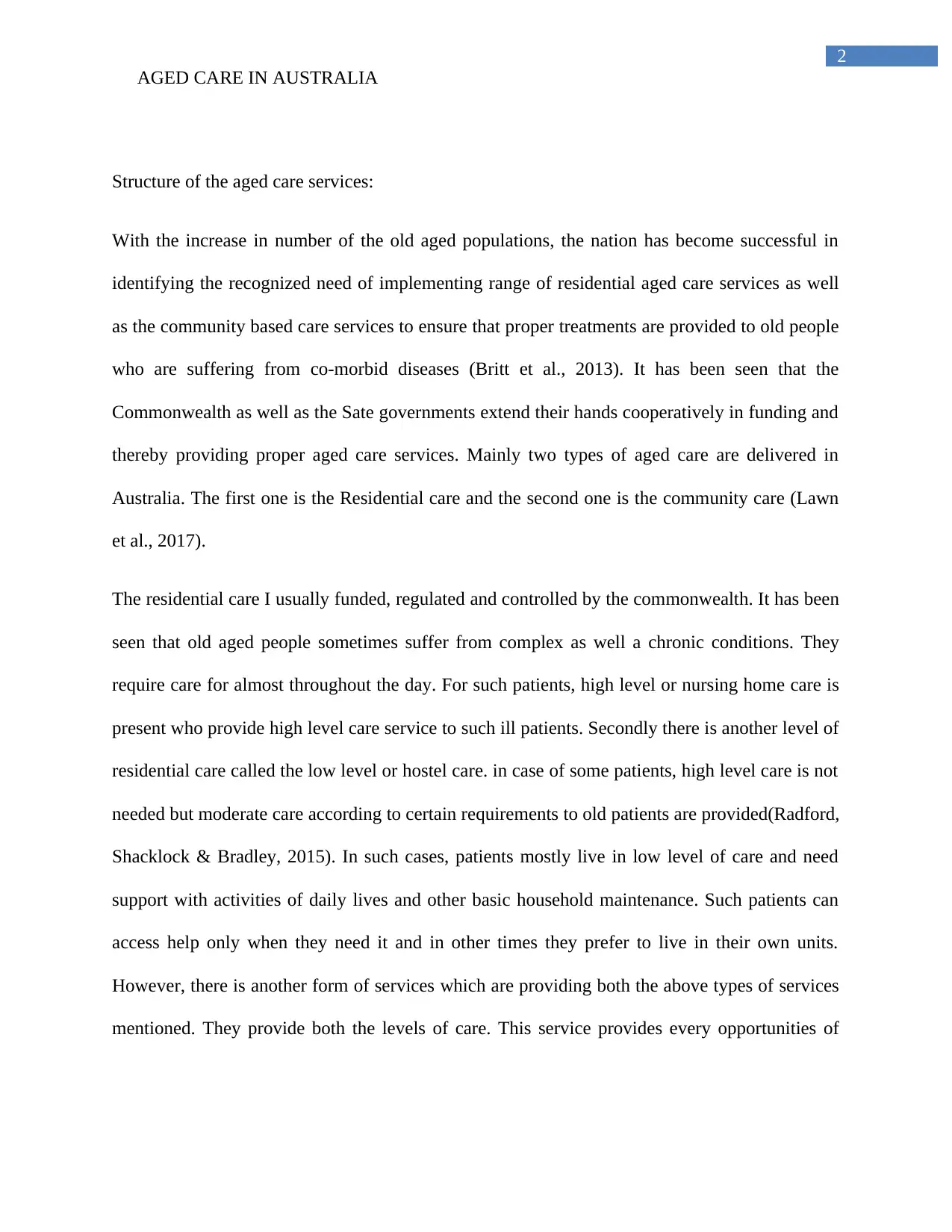
2
AGED CARE IN AUSTRALIA
Structure of the aged care services:
With the increase in number of the old aged populations, the nation has become successful in
identifying the recognized need of implementing range of residential aged care services as well
as the community based care services to ensure that proper treatments are provided to old people
who are suffering from co-morbid diseases (Britt et al., 2013). It has been seen that the
Commonwealth as well as the Sate governments extend their hands cooperatively in funding and
thereby providing proper aged care services. Mainly two types of aged care are delivered in
Australia. The first one is the Residential care and the second one is the community care (Lawn
et al., 2017).
The residential care I usually funded, regulated and controlled by the commonwealth. It has been
seen that old aged people sometimes suffer from complex as well a chronic conditions. They
require care for almost throughout the day. For such patients, high level or nursing home care is
present who provide high level care service to such ill patients. Secondly there is another level of
residential care called the low level or hostel care. in case of some patients, high level care is not
needed but moderate care according to certain requirements to old patients are provided(Radford,
Shacklock & Bradley, 2015). In such cases, patients mostly live in low level of care and need
support with activities of daily lives and other basic household maintenance. Such patients can
access help only when they need it and in other times they prefer to live in their own units.
However, there is another form of services which are providing both the above types of services
mentioned. They provide both the levels of care. This service provides every opportunities of
AGED CARE IN AUSTRALIA
Structure of the aged care services:
With the increase in number of the old aged populations, the nation has become successful in
identifying the recognized need of implementing range of residential aged care services as well
as the community based care services to ensure that proper treatments are provided to old people
who are suffering from co-morbid diseases (Britt et al., 2013). It has been seen that the
Commonwealth as well as the Sate governments extend their hands cooperatively in funding and
thereby providing proper aged care services. Mainly two types of aged care are delivered in
Australia. The first one is the Residential care and the second one is the community care (Lawn
et al., 2017).
The residential care I usually funded, regulated and controlled by the commonwealth. It has been
seen that old aged people sometimes suffer from complex as well a chronic conditions. They
require care for almost throughout the day. For such patients, high level or nursing home care is
present who provide high level care service to such ill patients. Secondly there is another level of
residential care called the low level or hostel care. in case of some patients, high level care is not
needed but moderate care according to certain requirements to old patients are provided(Radford,
Shacklock & Bradley, 2015). In such cases, patients mostly live in low level of care and need
support with activities of daily lives and other basic household maintenance. Such patients can
access help only when they need it and in other times they prefer to live in their own units.
However, there is another form of services which are providing both the above types of services
mentioned. They provide both the levels of care. This service provides every opportunities of
⊘ This is a preview!⊘
Do you want full access?
Subscribe today to unlock all pages.

Trusted by 1+ million students worldwide
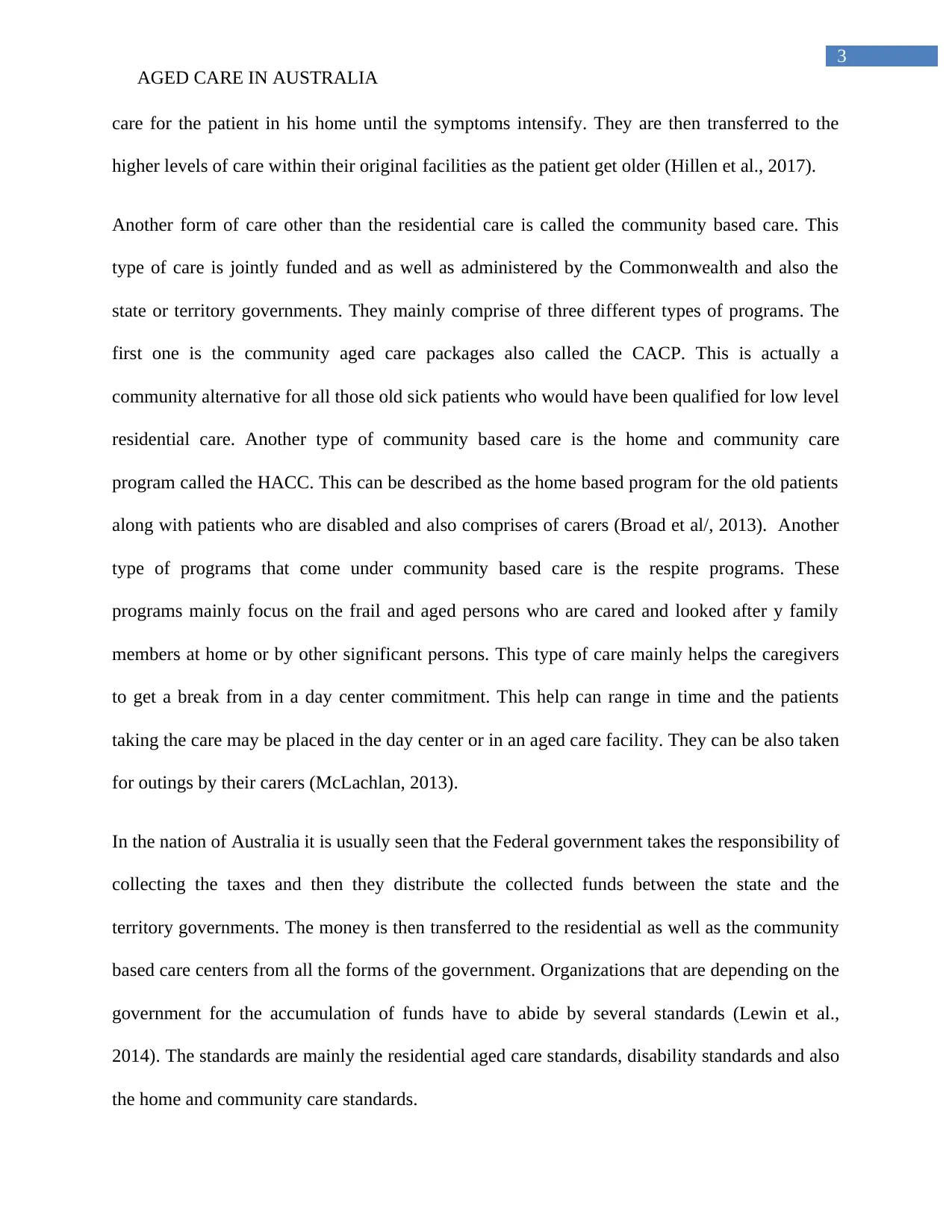
3
AGED CARE IN AUSTRALIA
care for the patient in his home until the symptoms intensify. They are then transferred to the
higher levels of care within their original facilities as the patient get older (Hillen et al., 2017).
Another form of care other than the residential care is called the community based care. This
type of care is jointly funded and as well as administered by the Commonwealth and also the
state or territory governments. They mainly comprise of three different types of programs. The
first one is the community aged care packages also called the CACP. This is actually a
community alternative for all those old sick patients who would have been qualified for low level
residential care. Another type of community based care is the home and community care
program called the HACC. This can be described as the home based program for the old patients
along with patients who are disabled and also comprises of carers (Broad et al/, 2013). Another
type of programs that come under community based care is the respite programs. These
programs mainly focus on the frail and aged persons who are cared and looked after y family
members at home or by other significant persons. This type of care mainly helps the caregivers
to get a break from in a day center commitment. This help can range in time and the patients
taking the care may be placed in the day center or in an aged care facility. They can be also taken
for outings by their carers (McLachlan, 2013).
In the nation of Australia it is usually seen that the Federal government takes the responsibility of
collecting the taxes and then they distribute the collected funds between the state and the
territory governments. The money is then transferred to the residential as well as the community
based care centers from all the forms of the government. Organizations that are depending on the
government for the accumulation of funds have to abide by several standards (Lewin et al.,
2014). The standards are mainly the residential aged care standards, disability standards and also
the home and community care standards.
AGED CARE IN AUSTRALIA
care for the patient in his home until the symptoms intensify. They are then transferred to the
higher levels of care within their original facilities as the patient get older (Hillen et al., 2017).
Another form of care other than the residential care is called the community based care. This
type of care is jointly funded and as well as administered by the Commonwealth and also the
state or territory governments. They mainly comprise of three different types of programs. The
first one is the community aged care packages also called the CACP. This is actually a
community alternative for all those old sick patients who would have been qualified for low level
residential care. Another type of community based care is the home and community care
program called the HACC. This can be described as the home based program for the old patients
along with patients who are disabled and also comprises of carers (Broad et al/, 2013). Another
type of programs that come under community based care is the respite programs. These
programs mainly focus on the frail and aged persons who are cared and looked after y family
members at home or by other significant persons. This type of care mainly helps the caregivers
to get a break from in a day center commitment. This help can range in time and the patients
taking the care may be placed in the day center or in an aged care facility. They can be also taken
for outings by their carers (McLachlan, 2013).
In the nation of Australia it is usually seen that the Federal government takes the responsibility of
collecting the taxes and then they distribute the collected funds between the state and the
territory governments. The money is then transferred to the residential as well as the community
based care centers from all the forms of the government. Organizations that are depending on the
government for the accumulation of funds have to abide by several standards (Lewin et al.,
2014). The standards are mainly the residential aged care standards, disability standards and also
the home and community care standards.
Paraphrase This Document
Need a fresh take? Get an instant paraphrase of this document with our AI Paraphraser
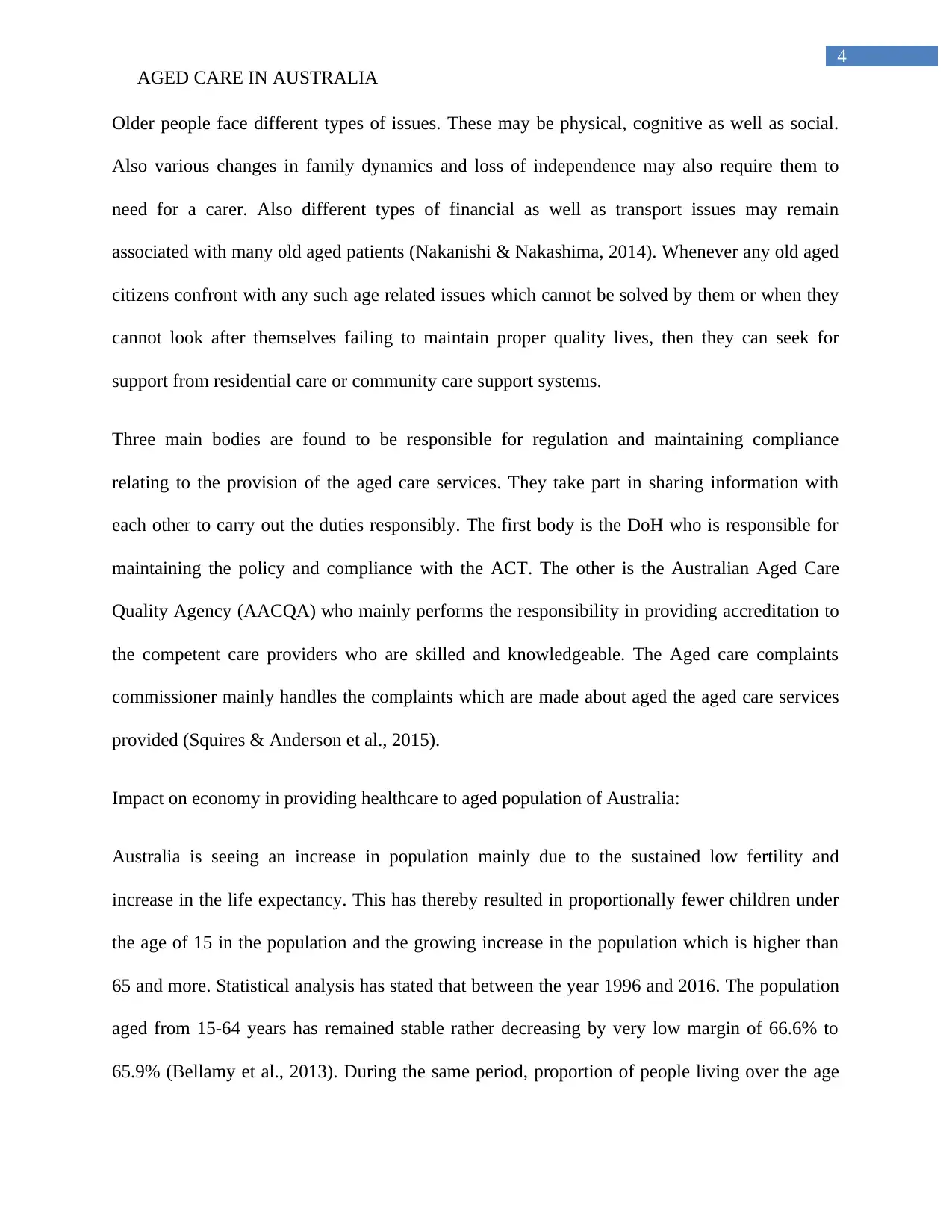
4
AGED CARE IN AUSTRALIA
Older people face different types of issues. These may be physical, cognitive as well as social.
Also various changes in family dynamics and loss of independence may also require them to
need for a carer. Also different types of financial as well as transport issues may remain
associated with many old aged patients (Nakanishi & Nakashima, 2014). Whenever any old aged
citizens confront with any such age related issues which cannot be solved by them or when they
cannot look after themselves failing to maintain proper quality lives, then they can seek for
support from residential care or community care support systems.
Three main bodies are found to be responsible for regulation and maintaining compliance
relating to the provision of the aged care services. They take part in sharing information with
each other to carry out the duties responsibly. The first body is the DoH who is responsible for
maintaining the policy and compliance with the ACT. The other is the Australian Aged Care
Quality Agency (AACQA) who mainly performs the responsibility in providing accreditation to
the competent care providers who are skilled and knowledgeable. The Aged care complaints
commissioner mainly handles the complaints which are made about aged the aged care services
provided (Squires & Anderson et al., 2015).
Impact on economy in providing healthcare to aged population of Australia:
Australia is seeing an increase in population mainly due to the sustained low fertility and
increase in the life expectancy. This has thereby resulted in proportionally fewer children under
the age of 15 in the population and the growing increase in the population which is higher than
65 and more. Statistical analysis has stated that between the year 1996 and 2016. The population
aged from 15-64 years has remained stable rather decreasing by very low margin of 66.6% to
65.9% (Bellamy et al., 2013). During the same period, proportion of people living over the age
AGED CARE IN AUSTRALIA
Older people face different types of issues. These may be physical, cognitive as well as social.
Also various changes in family dynamics and loss of independence may also require them to
need for a carer. Also different types of financial as well as transport issues may remain
associated with many old aged patients (Nakanishi & Nakashima, 2014). Whenever any old aged
citizens confront with any such age related issues which cannot be solved by them or when they
cannot look after themselves failing to maintain proper quality lives, then they can seek for
support from residential care or community care support systems.
Three main bodies are found to be responsible for regulation and maintaining compliance
relating to the provision of the aged care services. They take part in sharing information with
each other to carry out the duties responsibly. The first body is the DoH who is responsible for
maintaining the policy and compliance with the ACT. The other is the Australian Aged Care
Quality Agency (AACQA) who mainly performs the responsibility in providing accreditation to
the competent care providers who are skilled and knowledgeable. The Aged care complaints
commissioner mainly handles the complaints which are made about aged the aged care services
provided (Squires & Anderson et al., 2015).
Impact on economy in providing healthcare to aged population of Australia:
Australia is seeing an increase in population mainly due to the sustained low fertility and
increase in the life expectancy. This has thereby resulted in proportionally fewer children under
the age of 15 in the population and the growing increase in the population which is higher than
65 and more. Statistical analysis has stated that between the year 1996 and 2016. The population
aged from 15-64 years has remained stable rather decreasing by very low margin of 66.6% to
65.9% (Bellamy et al., 2013). During the same period, proportion of people living over the age
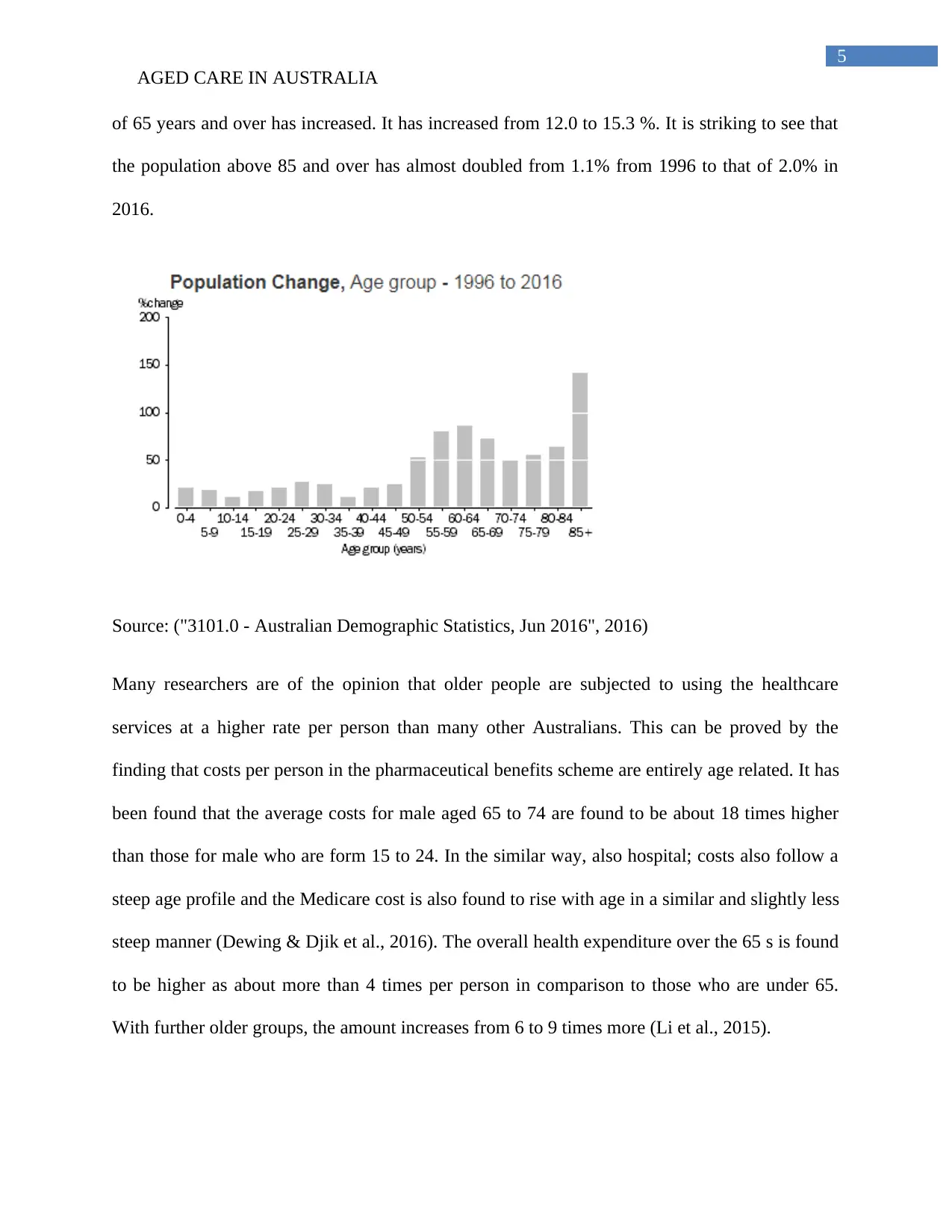
5
AGED CARE IN AUSTRALIA
of 65 years and over has increased. It has increased from 12.0 to 15.3 %. It is striking to see that
the population above 85 and over has almost doubled from 1.1% from 1996 to that of 2.0% in
2016.
Source: ("3101.0 - Australian Demographic Statistics, Jun 2016", 2016)
Many researchers are of the opinion that older people are subjected to using the healthcare
services at a higher rate per person than many other Australians. This can be proved by the
finding that costs per person in the pharmaceutical benefits scheme are entirely age related. It has
been found that the average costs for male aged 65 to 74 are found to be about 18 times higher
than those for male who are form 15 to 24. In the similar way, also hospital; costs also follow a
steep age profile and the Medicare cost is also found to rise with age in a similar and slightly less
steep manner (Dewing & Djik et al., 2016). The overall health expenditure over the 65 s is found
to be higher as about more than 4 times per person in comparison to those who are under 65.
With further older groups, the amount increases from 6 to 9 times more (Li et al., 2015).
AGED CARE IN AUSTRALIA
of 65 years and over has increased. It has increased from 12.0 to 15.3 %. It is striking to see that
the population above 85 and over has almost doubled from 1.1% from 1996 to that of 2.0% in
2016.
Source: ("3101.0 - Australian Demographic Statistics, Jun 2016", 2016)
Many researchers are of the opinion that older people are subjected to using the healthcare
services at a higher rate per person than many other Australians. This can be proved by the
finding that costs per person in the pharmaceutical benefits scheme are entirely age related. It has
been found that the average costs for male aged 65 to 74 are found to be about 18 times higher
than those for male who are form 15 to 24. In the similar way, also hospital; costs also follow a
steep age profile and the Medicare cost is also found to rise with age in a similar and slightly less
steep manner (Dewing & Djik et al., 2016). The overall health expenditure over the 65 s is found
to be higher as about more than 4 times per person in comparison to those who are under 65.
With further older groups, the amount increases from 6 to 9 times more (Li et al., 2015).
⊘ This is a preview!⊘
Do you want full access?
Subscribe today to unlock all pages.

Trusted by 1+ million students worldwide
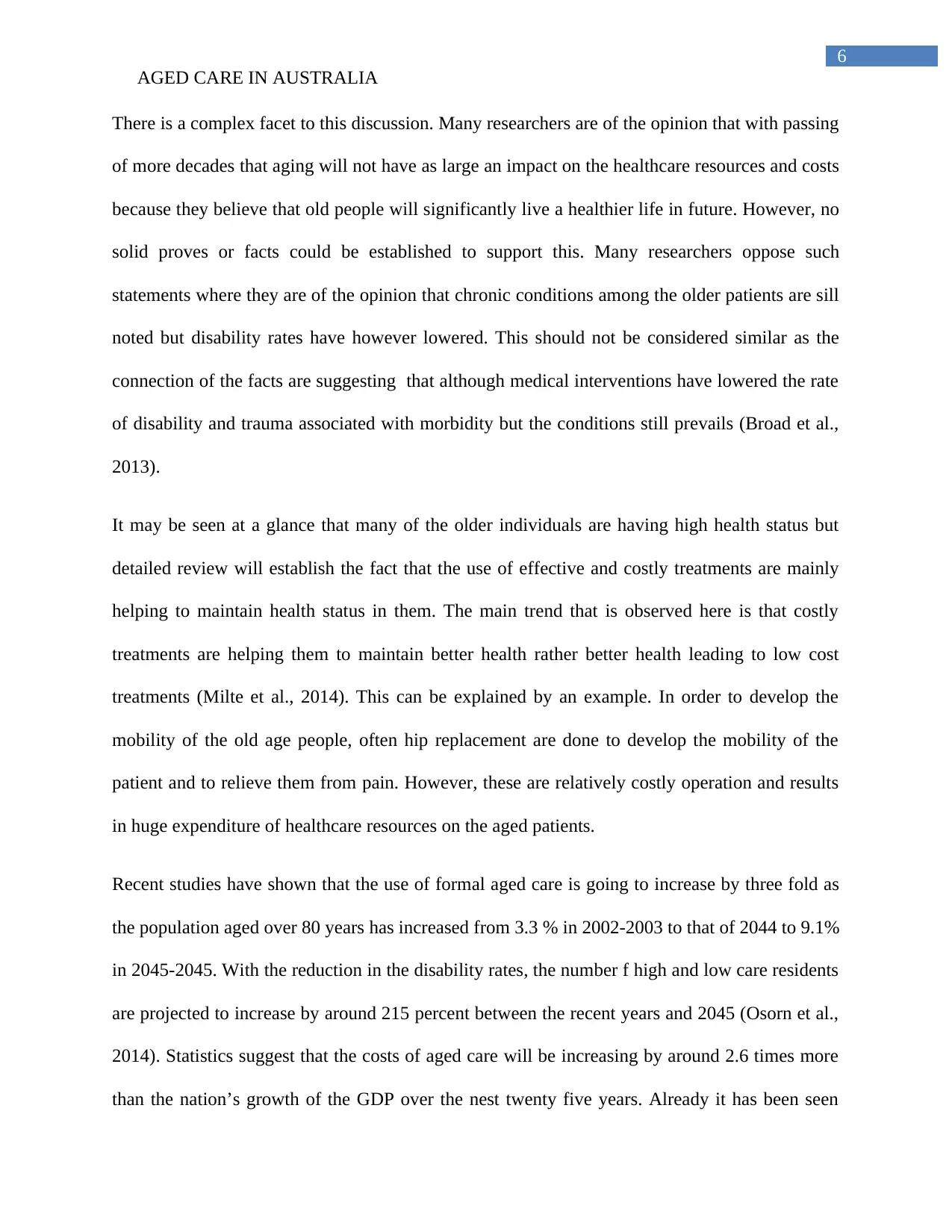
6
AGED CARE IN AUSTRALIA
There is a complex facet to this discussion. Many researchers are of the opinion that with passing
of more decades that aging will not have as large an impact on the healthcare resources and costs
because they believe that old people will significantly live a healthier life in future. However, no
solid proves or facts could be established to support this. Many researchers oppose such
statements where they are of the opinion that chronic conditions among the older patients are sill
noted but disability rates have however lowered. This should not be considered similar as the
connection of the facts are suggesting that although medical interventions have lowered the rate
of disability and trauma associated with morbidity but the conditions still prevails (Broad et al.,
2013).
It may be seen at a glance that many of the older individuals are having high health status but
detailed review will establish the fact that the use of effective and costly treatments are mainly
helping to maintain health status in them. The main trend that is observed here is that costly
treatments are helping them to maintain better health rather better health leading to low cost
treatments (Milte et al., 2014). This can be explained by an example. In order to develop the
mobility of the old age people, often hip replacement are done to develop the mobility of the
patient and to relieve them from pain. However, these are relatively costly operation and results
in huge expenditure of healthcare resources on the aged patients.
Recent studies have shown that the use of formal aged care is going to increase by three fold as
the population aged over 80 years has increased from 3.3 % in 2002-2003 to that of 2044 to 9.1%
in 2045-2045. With the reduction in the disability rates, the number f high and low care residents
are projected to increase by around 215 percent between the recent years and 2045 (Osorn et al.,
2014). Statistics suggest that the costs of aged care will be increasing by around 2.6 times more
than the nation’s growth of the GDP over the nest twenty five years. Already it has been seen
AGED CARE IN AUSTRALIA
There is a complex facet to this discussion. Many researchers are of the opinion that with passing
of more decades that aging will not have as large an impact on the healthcare resources and costs
because they believe that old people will significantly live a healthier life in future. However, no
solid proves or facts could be established to support this. Many researchers oppose such
statements where they are of the opinion that chronic conditions among the older patients are sill
noted but disability rates have however lowered. This should not be considered similar as the
connection of the facts are suggesting that although medical interventions have lowered the rate
of disability and trauma associated with morbidity but the conditions still prevails (Broad et al.,
2013).
It may be seen at a glance that many of the older individuals are having high health status but
detailed review will establish the fact that the use of effective and costly treatments are mainly
helping to maintain health status in them. The main trend that is observed here is that costly
treatments are helping them to maintain better health rather better health leading to low cost
treatments (Milte et al., 2014). This can be explained by an example. In order to develop the
mobility of the old age people, often hip replacement are done to develop the mobility of the
patient and to relieve them from pain. However, these are relatively costly operation and results
in huge expenditure of healthcare resources on the aged patients.
Recent studies have shown that the use of formal aged care is going to increase by three fold as
the population aged over 80 years has increased from 3.3 % in 2002-2003 to that of 2044 to 9.1%
in 2045-2045. With the reduction in the disability rates, the number f high and low care residents
are projected to increase by around 215 percent between the recent years and 2045 (Osorn et al.,
2014). Statistics suggest that the costs of aged care will be increasing by around 2.6 times more
than the nation’s growth of the GDP over the nest twenty five years. Already it has been seen
Paraphrase This Document
Need a fresh take? Get an instant paraphrase of this document with our AI Paraphraser
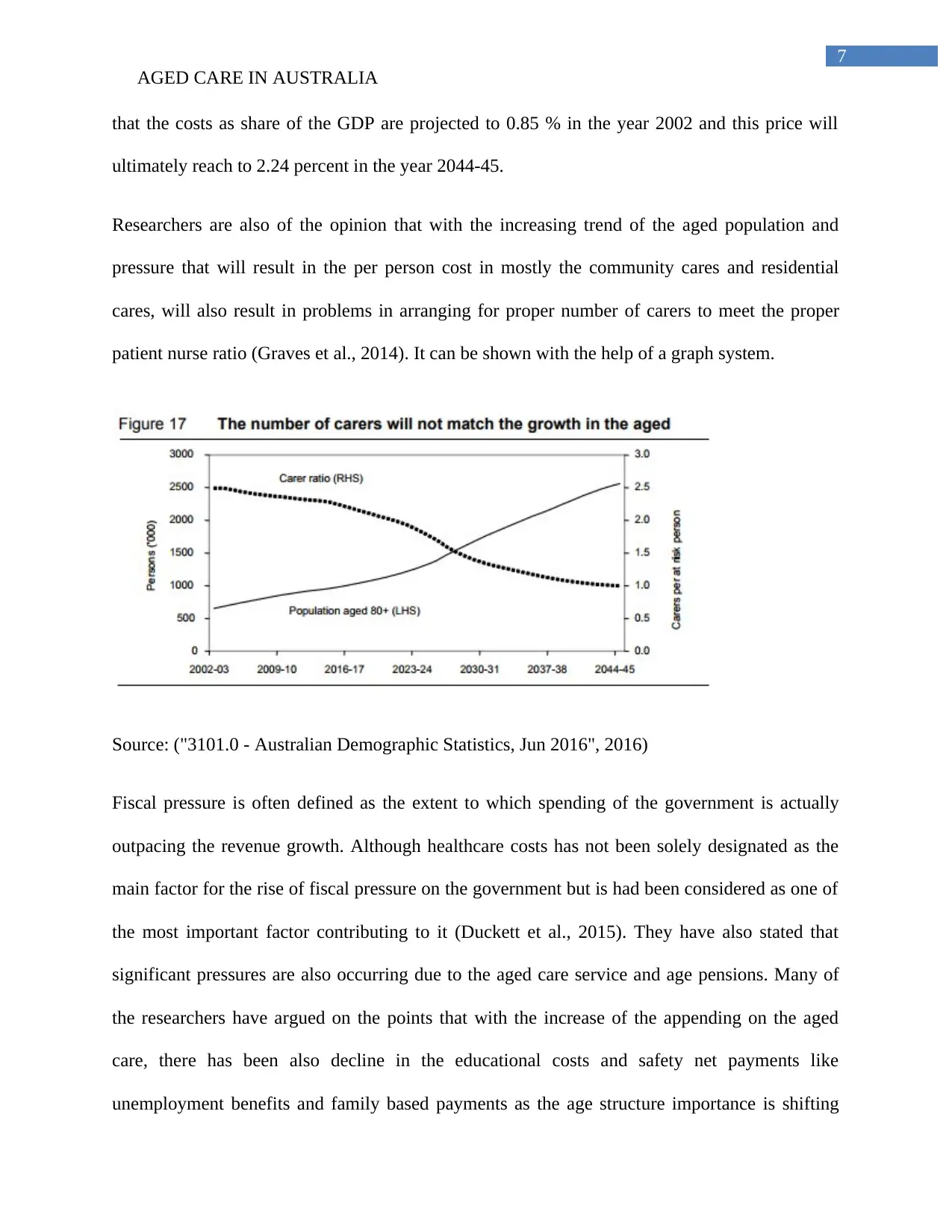
7
AGED CARE IN AUSTRALIA
that the costs as share of the GDP are projected to 0.85 % in the year 2002 and this price will
ultimately reach to 2.24 percent in the year 2044-45.
Researchers are also of the opinion that with the increasing trend of the aged population and
pressure that will result in the per person cost in mostly the community cares and residential
cares, will also result in problems in arranging for proper number of carers to meet the proper
patient nurse ratio (Graves et al., 2014). It can be shown with the help of a graph system.
Source: ("3101.0 - Australian Demographic Statistics, Jun 2016", 2016)
Fiscal pressure is often defined as the extent to which spending of the government is actually
outpacing the revenue growth. Although healthcare costs has not been solely designated as the
main factor for the rise of fiscal pressure on the government but is had been considered as one of
the most important factor contributing to it (Duckett et al., 2015). They have also stated that
significant pressures are also occurring due to the aged care service and age pensions. Many of
the researchers have argued on the points that with the increase of the appending on the aged
care, there has been also decline in the educational costs and safety net payments like
unemployment benefits and family based payments as the age structure importance is shifting
AGED CARE IN AUSTRALIA
that the costs as share of the GDP are projected to 0.85 % in the year 2002 and this price will
ultimately reach to 2.24 percent in the year 2044-45.
Researchers are also of the opinion that with the increasing trend of the aged population and
pressure that will result in the per person cost in mostly the community cares and residential
cares, will also result in problems in arranging for proper number of carers to meet the proper
patient nurse ratio (Graves et al., 2014). It can be shown with the help of a graph system.
Source: ("3101.0 - Australian Demographic Statistics, Jun 2016", 2016)
Fiscal pressure is often defined as the extent to which spending of the government is actually
outpacing the revenue growth. Although healthcare costs has not been solely designated as the
main factor for the rise of fiscal pressure on the government but is had been considered as one of
the most important factor contributing to it (Duckett et al., 2015). They have also stated that
significant pressures are also occurring due to the aged care service and age pensions. Many of
the researchers have argued on the points that with the increase of the appending on the aged
care, there has been also decline in the educational costs and safety net payments like
unemployment benefits and family based payments as the age structure importance is shifting
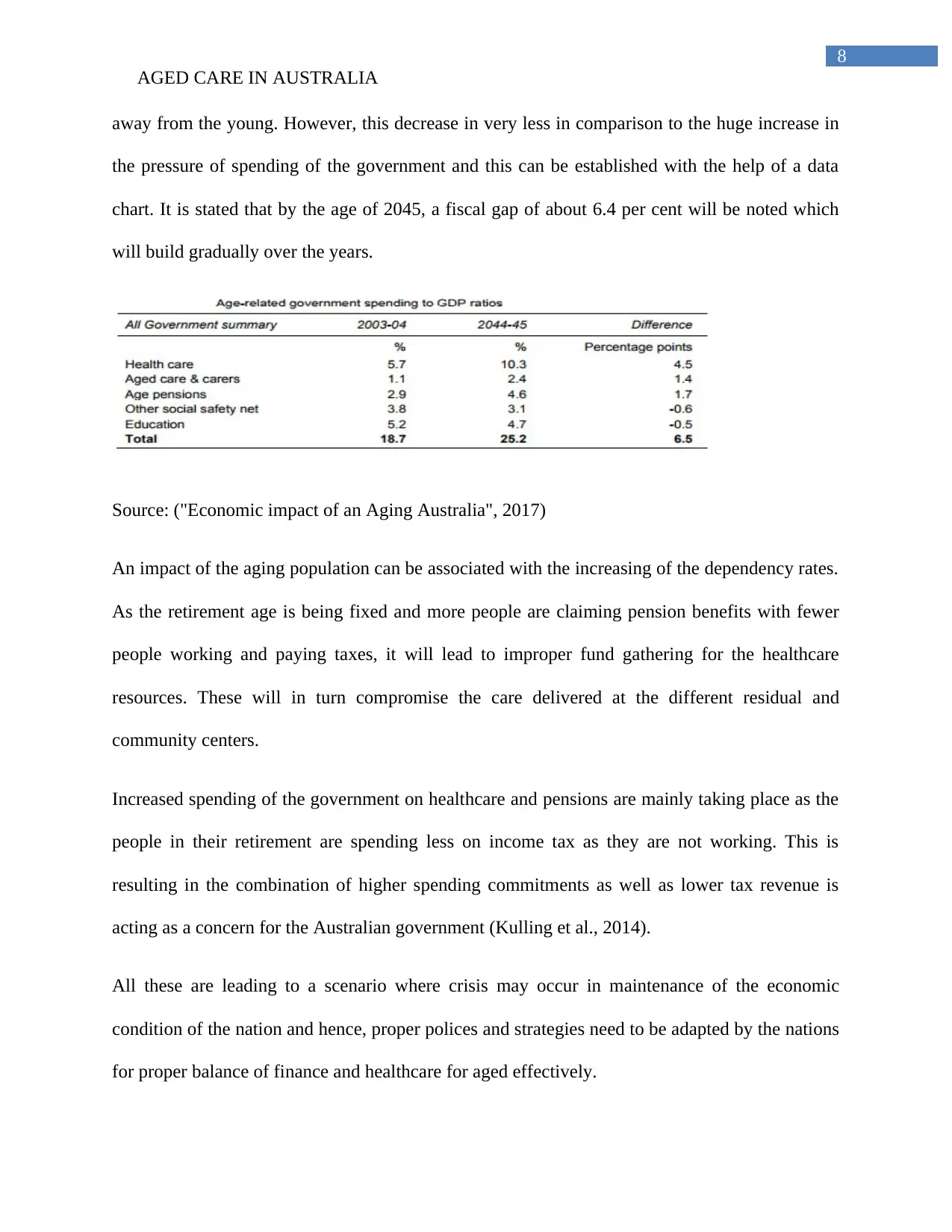
8
AGED CARE IN AUSTRALIA
away from the young. However, this decrease in very less in comparison to the huge increase in
the pressure of spending of the government and this can be established with the help of a data
chart. It is stated that by the age of 2045, a fiscal gap of about 6.4 per cent will be noted which
will build gradually over the years.
Source: ("Economic impact of an Aging Australia", 2017)
An impact of the aging population can be associated with the increasing of the dependency rates.
As the retirement age is being fixed and more people are claiming pension benefits with fewer
people working and paying taxes, it will lead to improper fund gathering for the healthcare
resources. These will in turn compromise the care delivered at the different residual and
community centers.
Increased spending of the government on healthcare and pensions are mainly taking place as the
people in their retirement are spending less on income tax as they are not working. This is
resulting in the combination of higher spending commitments as well as lower tax revenue is
acting as a concern for the Australian government (Kulling et al., 2014).
All these are leading to a scenario where crisis may occur in maintenance of the economic
condition of the nation and hence, proper polices and strategies need to be adapted by the nations
for proper balance of finance and healthcare for aged effectively.
AGED CARE IN AUSTRALIA
away from the young. However, this decrease in very less in comparison to the huge increase in
the pressure of spending of the government and this can be established with the help of a data
chart. It is stated that by the age of 2045, a fiscal gap of about 6.4 per cent will be noted which
will build gradually over the years.
Source: ("Economic impact of an Aging Australia", 2017)
An impact of the aging population can be associated with the increasing of the dependency rates.
As the retirement age is being fixed and more people are claiming pension benefits with fewer
people working and paying taxes, it will lead to improper fund gathering for the healthcare
resources. These will in turn compromise the care delivered at the different residual and
community centers.
Increased spending of the government on healthcare and pensions are mainly taking place as the
people in their retirement are spending less on income tax as they are not working. This is
resulting in the combination of higher spending commitments as well as lower tax revenue is
acting as a concern for the Australian government (Kulling et al., 2014).
All these are leading to a scenario where crisis may occur in maintenance of the economic
condition of the nation and hence, proper polices and strategies need to be adapted by the nations
for proper balance of finance and healthcare for aged effectively.
⊘ This is a preview!⊘
Do you want full access?
Subscribe today to unlock all pages.

Trusted by 1+ million students worldwide
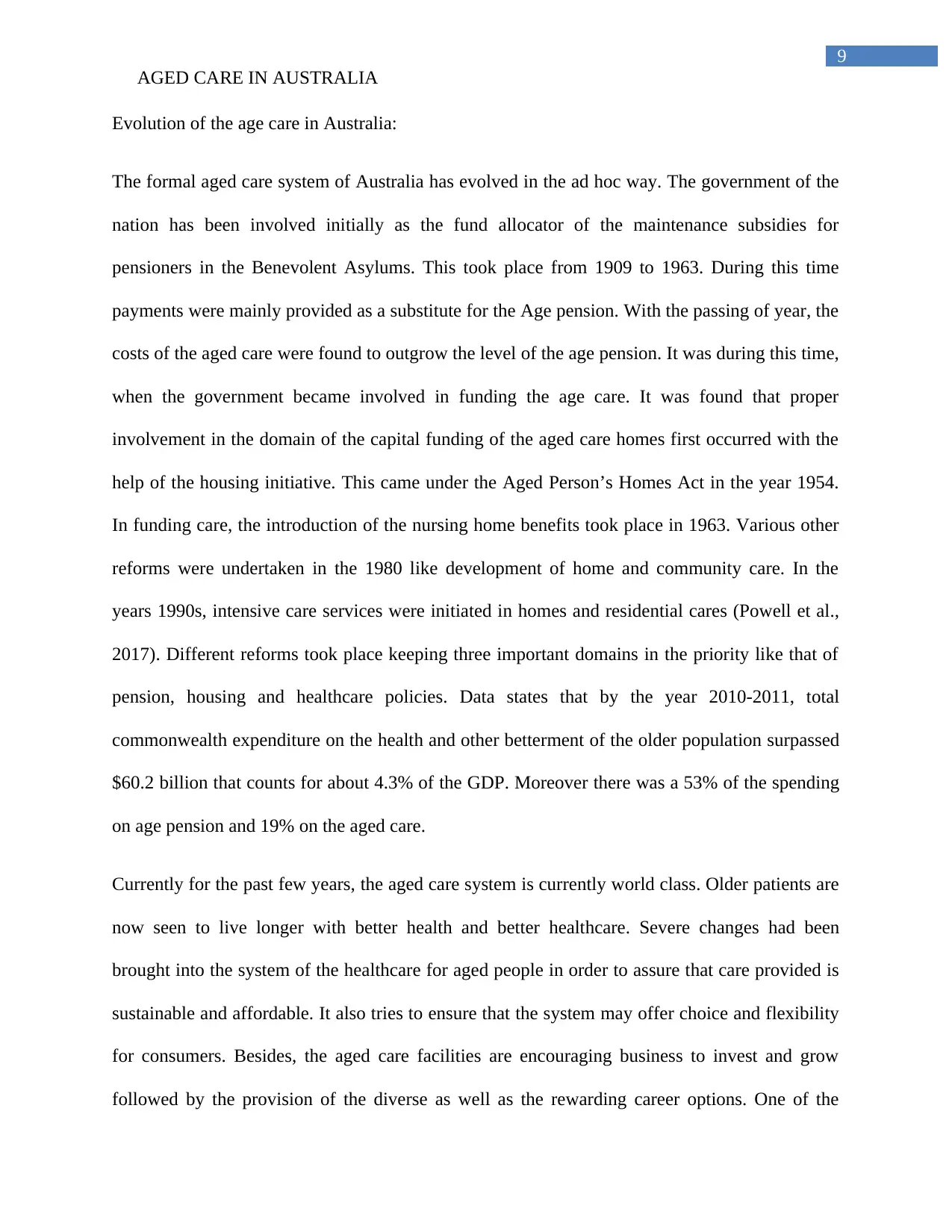
9
AGED CARE IN AUSTRALIA
Evolution of the age care in Australia:
The formal aged care system of Australia has evolved in the ad hoc way. The government of the
nation has been involved initially as the fund allocator of the maintenance subsidies for
pensioners in the Benevolent Asylums. This took place from 1909 to 1963. During this time
payments were mainly provided as a substitute for the Age pension. With the passing of year, the
costs of the aged care were found to outgrow the level of the age pension. It was during this time,
when the government became involved in funding the age care. It was found that proper
involvement in the domain of the capital funding of the aged care homes first occurred with the
help of the housing initiative. This came under the Aged Person’s Homes Act in the year 1954.
In funding care, the introduction of the nursing home benefits took place in 1963. Various other
reforms were undertaken in the 1980 like development of home and community care. In the
years 1990s, intensive care services were initiated in homes and residential cares (Powell et al.,
2017). Different reforms took place keeping three important domains in the priority like that of
pension, housing and healthcare policies. Data states that by the year 2010-2011, total
commonwealth expenditure on the health and other betterment of the older population surpassed
$60.2 billion that counts for about 4.3% of the GDP. Moreover there was a 53% of the spending
on age pension and 19% on the aged care.
Currently for the past few years, the aged care system is currently world class. Older patients are
now seen to live longer with better health and better healthcare. Severe changes had been
brought into the system of the healthcare for aged people in order to assure that care provided is
sustainable and affordable. It also tries to ensure that the system may offer choice and flexibility
for consumers. Besides, the aged care facilities are encouraging business to invest and grow
followed by the provision of the diverse as well as the rewarding career options. One of the
AGED CARE IN AUSTRALIA
Evolution of the age care in Australia:
The formal aged care system of Australia has evolved in the ad hoc way. The government of the
nation has been involved initially as the fund allocator of the maintenance subsidies for
pensioners in the Benevolent Asylums. This took place from 1909 to 1963. During this time
payments were mainly provided as a substitute for the Age pension. With the passing of year, the
costs of the aged care were found to outgrow the level of the age pension. It was during this time,
when the government became involved in funding the age care. It was found that proper
involvement in the domain of the capital funding of the aged care homes first occurred with the
help of the housing initiative. This came under the Aged Person’s Homes Act in the year 1954.
In funding care, the introduction of the nursing home benefits took place in 1963. Various other
reforms were undertaken in the 1980 like development of home and community care. In the
years 1990s, intensive care services were initiated in homes and residential cares (Powell et al.,
2017). Different reforms took place keeping three important domains in the priority like that of
pension, housing and healthcare policies. Data states that by the year 2010-2011, total
commonwealth expenditure on the health and other betterment of the older population surpassed
$60.2 billion that counts for about 4.3% of the GDP. Moreover there was a 53% of the spending
on age pension and 19% on the aged care.
Currently for the past few years, the aged care system is currently world class. Older patients are
now seen to live longer with better health and better healthcare. Severe changes had been
brought into the system of the healthcare for aged people in order to assure that care provided is
sustainable and affordable. It also tries to ensure that the system may offer choice and flexibility
for consumers. Besides, the aged care facilities are encouraging business to invest and grow
followed by the provision of the diverse as well as the rewarding career options. One of the
Paraphrase This Document
Need a fresh take? Get an instant paraphrase of this document with our AI Paraphraser
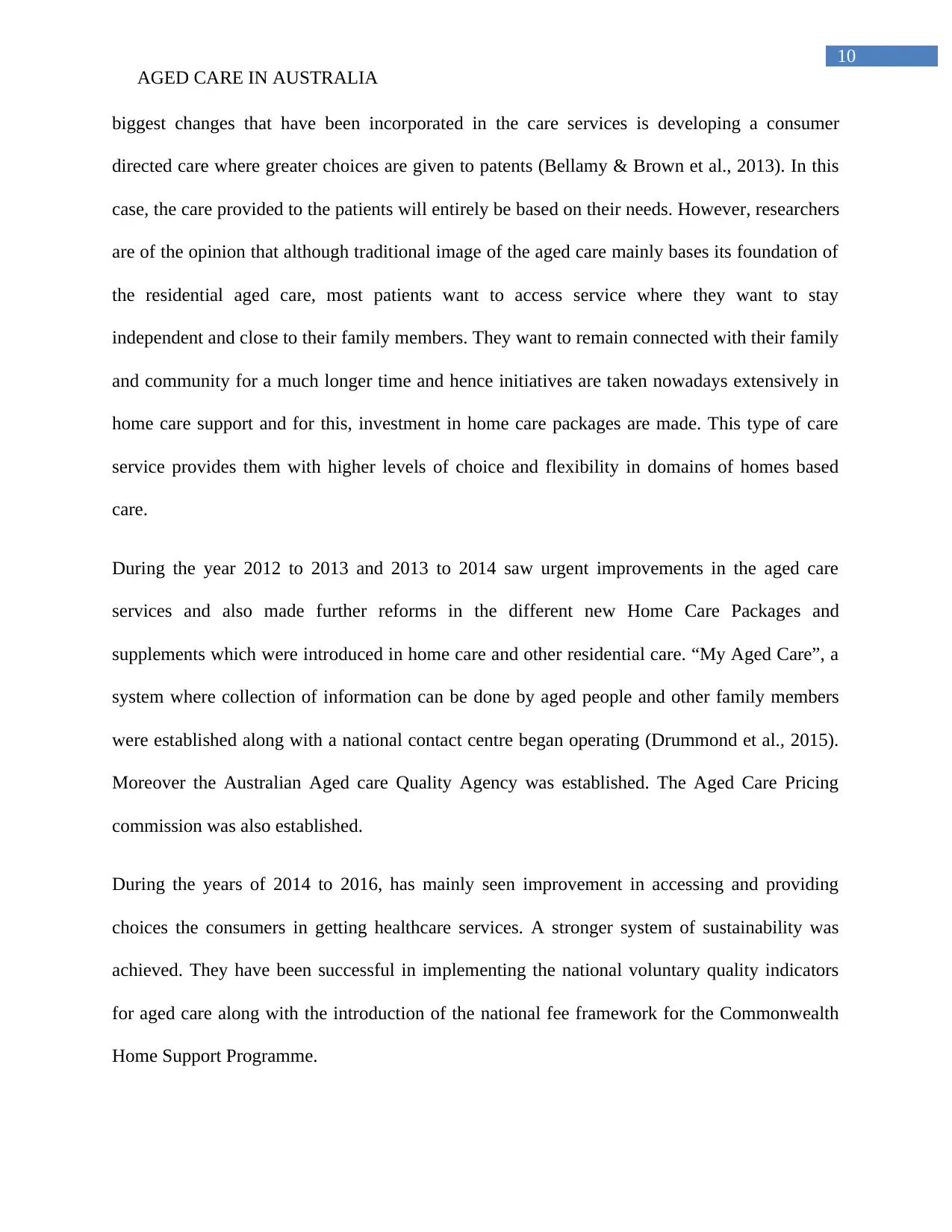
10
AGED CARE IN AUSTRALIA
biggest changes that have been incorporated in the care services is developing a consumer
directed care where greater choices are given to patents (Bellamy & Brown et al., 2013). In this
case, the care provided to the patients will entirely be based on their needs. However, researchers
are of the opinion that although traditional image of the aged care mainly bases its foundation of
the residential aged care, most patients want to access service where they want to stay
independent and close to their family members. They want to remain connected with their family
and community for a much longer time and hence initiatives are taken nowadays extensively in
home care support and for this, investment in home care packages are made. This type of care
service provides them with higher levels of choice and flexibility in domains of homes based
care.
During the year 2012 to 2013 and 2013 to 2014 saw urgent improvements in the aged care
services and also made further reforms in the different new Home Care Packages and
supplements which were introduced in home care and other residential care. “My Aged Care”, a
system where collection of information can be done by aged people and other family members
were established along with a national contact centre began operating (Drummond et al., 2015).
Moreover the Australian Aged care Quality Agency was established. The Aged Care Pricing
commission was also established.
During the years of 2014 to 2016, has mainly seen improvement in accessing and providing
choices the consumers in getting healthcare services. A stronger system of sustainability was
achieved. They have been successful in implementing the national voluntary quality indicators
for aged care along with the introduction of the national fee framework for the Commonwealth
Home Support Programme.
AGED CARE IN AUSTRALIA
biggest changes that have been incorporated in the care services is developing a consumer
directed care where greater choices are given to patents (Bellamy & Brown et al., 2013). In this
case, the care provided to the patients will entirely be based on their needs. However, researchers
are of the opinion that although traditional image of the aged care mainly bases its foundation of
the residential aged care, most patients want to access service where they want to stay
independent and close to their family members. They want to remain connected with their family
and community for a much longer time and hence initiatives are taken nowadays extensively in
home care support and for this, investment in home care packages are made. This type of care
service provides them with higher levels of choice and flexibility in domains of homes based
care.
During the year 2012 to 2013 and 2013 to 2014 saw urgent improvements in the aged care
services and also made further reforms in the different new Home Care Packages and
supplements which were introduced in home care and other residential care. “My Aged Care”, a
system where collection of information can be done by aged people and other family members
were established along with a national contact centre began operating (Drummond et al., 2015).
Moreover the Australian Aged care Quality Agency was established. The Aged Care Pricing
commission was also established.
During the years of 2014 to 2016, has mainly seen improvement in accessing and providing
choices the consumers in getting healthcare services. A stronger system of sustainability was
achieved. They have been successful in implementing the national voluntary quality indicators
for aged care along with the introduction of the national fee framework for the Commonwealth
Home Support Programme.
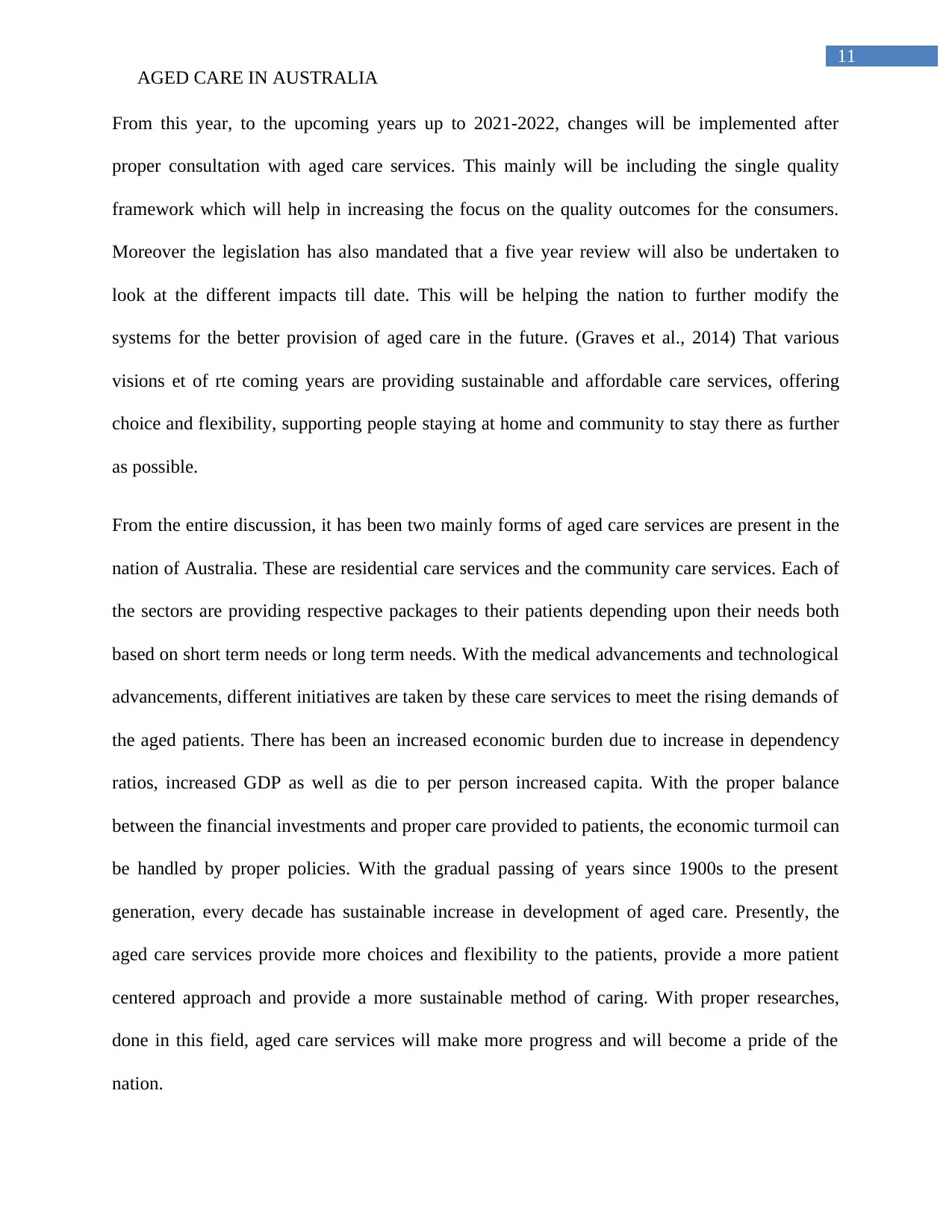
11
AGED CARE IN AUSTRALIA
From this year, to the upcoming years up to 2021-2022, changes will be implemented after
proper consultation with aged care services. This mainly will be including the single quality
framework which will help in increasing the focus on the quality outcomes for the consumers.
Moreover the legislation has also mandated that a five year review will also be undertaken to
look at the different impacts till date. This will be helping the nation to further modify the
systems for the better provision of aged care in the future. (Graves et al., 2014) That various
visions et of rte coming years are providing sustainable and affordable care services, offering
choice and flexibility, supporting people staying at home and community to stay there as further
as possible.
From the entire discussion, it has been two mainly forms of aged care services are present in the
nation of Australia. These are residential care services and the community care services. Each of
the sectors are providing respective packages to their patients depending upon their needs both
based on short term needs or long term needs. With the medical advancements and technological
advancements, different initiatives are taken by these care services to meet the rising demands of
the aged patients. There has been an increased economic burden due to increase in dependency
ratios, increased GDP as well as die to per person increased capita. With the proper balance
between the financial investments and proper care provided to patients, the economic turmoil can
be handled by proper policies. With the gradual passing of years since 1900s to the present
generation, every decade has sustainable increase in development of aged care. Presently, the
aged care services provide more choices and flexibility to the patients, provide a more patient
centered approach and provide a more sustainable method of caring. With proper researches,
done in this field, aged care services will make more progress and will become a pride of the
nation.
AGED CARE IN AUSTRALIA
From this year, to the upcoming years up to 2021-2022, changes will be implemented after
proper consultation with aged care services. This mainly will be including the single quality
framework which will help in increasing the focus on the quality outcomes for the consumers.
Moreover the legislation has also mandated that a five year review will also be undertaken to
look at the different impacts till date. This will be helping the nation to further modify the
systems for the better provision of aged care in the future. (Graves et al., 2014) That various
visions et of rte coming years are providing sustainable and affordable care services, offering
choice and flexibility, supporting people staying at home and community to stay there as further
as possible.
From the entire discussion, it has been two mainly forms of aged care services are present in the
nation of Australia. These are residential care services and the community care services. Each of
the sectors are providing respective packages to their patients depending upon their needs both
based on short term needs or long term needs. With the medical advancements and technological
advancements, different initiatives are taken by these care services to meet the rising demands of
the aged patients. There has been an increased economic burden due to increase in dependency
ratios, increased GDP as well as die to per person increased capita. With the proper balance
between the financial investments and proper care provided to patients, the economic turmoil can
be handled by proper policies. With the gradual passing of years since 1900s to the present
generation, every decade has sustainable increase in development of aged care. Presently, the
aged care services provide more choices and flexibility to the patients, provide a more patient
centered approach and provide a more sustainable method of caring. With proper researches,
done in this field, aged care services will make more progress and will become a pride of the
nation.
⊘ This is a preview!⊘
Do you want full access?
Subscribe today to unlock all pages.

Trusted by 1+ million students worldwide
1 out of 16
Related Documents
Your All-in-One AI-Powered Toolkit for Academic Success.
+13062052269
info@desklib.com
Available 24*7 on WhatsApp / Email
![[object Object]](/_next/static/media/star-bottom.7253800d.svg)
Unlock your academic potential
Copyright © 2020–2025 A2Z Services. All Rights Reserved. Developed and managed by ZUCOL.





